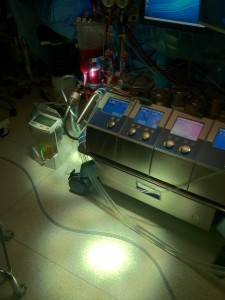Earlier this year, I visited Cedars-Sinai Medical Center to report a story for US News & World Report’s Best Hospitals issue. My assignment: meet heart patients, talk to surgeons, observe operations, and then write about it.

The first procedure I watched was an aortic valve replacement. The new, artificial valve was snaked up to the heart through the patient’s femoral artery. It was a tidy operation, done quickly and without complication.
The second procedure was a mitral valve repair. For this, the surgeon opted to use a surgical robot. After the patient’s heart was stopped and her blood safely pumping through the heart-lung machine (left), the surgeon stepped away from the operating table and sat down at a console. Viewing the heart in 3D, he slipped his fingers into the sensitive robotic controls through which he maneuvered remote tools at the operating table. On the OR monitor, I watched as the surgeon, via a set of robot arms, quite literally tugged and cut the patient’s heart strings (chordae tendineae), trimmed the oversized valve, and stitched it all up again.
Here’s a view from the robotic console:
Here’s a view from the table, robotic arms in motion:
The third surgery, a heart transplant, was harrowing to watch and frankly, difficult to stomach. The smells (a sawed-through sternum), sights (an empty chest cavity), and sounds (a beating heart plopped into a plastic bowl) made my knees weak. More than once, I had to sit down to take a deep breath.
During the procedure, I was surprised to see the patient’s heart still beating outside her body for about five minutes after it was removed.
Here’s a video of the beating heart soon after it was removed from the patient:
A few minutes after removal, slowing down:
All surgeries were successful. Patients recovered fully and without complications. If you’re interested in learning more about the patients and procedures, and seeing some amazing photographs by Daryl Peveto, I encourage you to read the story here.

 Our goal as HI-SEAS crew is to get good data about food during the mission. So in addition to rehydrating food, cooking meals for six, and cleaning dishes, we will keep tabs on the ingredients we choose, the time it takes to prepare the meal, and the amount of water we use.
Our goal as HI-SEAS crew is to get good data about food during the mission. So in addition to rehydrating food, cooking meals for six, and cleaning dishes, we will keep tabs on the ingredients we choose, the time it takes to prepare the meal, and the amount of water we use.

 For the past couple of years, I’ve been writing short and medium-length features for U.S. News & World Report. These stories aren’t available online, but you can read them in the special “books” U.S. News puts out called “Best Hospitals”, “Secrets of your Brain,” “Amazing Animals,” and “Mysteries of Space.”
For the past couple of years, I’ve been writing short and medium-length features for U.S. News & World Report. These stories aren’t available online, but you can read them in the special “books” U.S. News puts out called “Best Hospitals”, “Secrets of your Brain,” “Amazing Animals,” and “Mysteries of Space.”